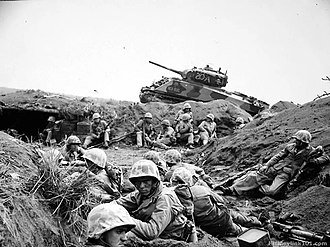Introduction
The year 1945 marked the end of the grueling Battle of Iwo Jima, a pivotal engagement during World War II. This battle, fought between American and Japanese forces, concluded on March 26, 1945, after weeks of intense fighting. The Battle of Iwo Jima had a significant impact on the course of the war in the Pacific, resulting in heavy casualties on both sides. In this article, we will delve into the historical information, evidence, and the strategic importance of this battle.
The Battle of Iwo Jima
The Battle of Iwo Jima was fought on the small volcanic island of Iwo Jima, located approximately 750 miles south of Tokyo, Japan. The island held great strategic importance for both the United States and Japan. For the Japanese, it served as a crucial defensive position, protecting their mainland from potential American air raids. On the other hand, the United States saw Iwo Jima as a vital stepping stone towards an eventual invasion of mainland Japan.
Heavy Casualties and Fierce Resistance
The battle commenced on February 19, 1945, with the landing of American troops on the shores of Iwo Jima. The Japanese forces, deeply entrenched and well-prepared, unleashed a relentless defense, resulting in heavy casualties for the Americans. The Japanese soldiers fought fiercely, often resorting to underground tunnels and fortified positions, making it difficult for the Americans to advance.
The battle was marked by intense combat, with both sides engaging in close-quarters fighting. The American forces faced numerous challenges, including the rugged terrain, extensive network of tunnels, and the constant threat of Japanese counterattacks. Despite these obstacles, the American troops persevered, inching their way forward through the island.
The Strategic Importance
The capture of Iwo Jima held immense strategic importance for the United States. The island provided a crucial airbase for American bombers, allowing them to conduct devastating air raids on the Japanese mainland. With Iwo Jima under their control, the American forces gained a significant advantage in their ability to strike at Japan’s industrial centers and military installations.
Moreover, the capture of Iwo Jima had a psychological impact on both the American and Japanese forces. The American victory at Iwo Jima boosted morale and served as a symbol of their determination to prevail in the Pacific. Conversely, the Japanese forces suffered a significant blow, realizing the relentless advance of the American military.
Conclusion
In conclusion, the Battle of Iwo Jima came to an end on March 26, 1945, after weeks of fierce fighting. This pivotal engagement during World War II resulted in heavy casualties for both the American and Japanese forces. The capture of Iwo Jima provided the United States with a strategic airbase, enabling them to launch devastating air raids on the Japanese mainland. The battle’s significance extended beyond its military impact, as it served as a symbol of American perseverance and determination in the face of adversity. The Battle of Iwo Jima remains etched in history as a testament to the sacrifices made by those who fought on the island.

